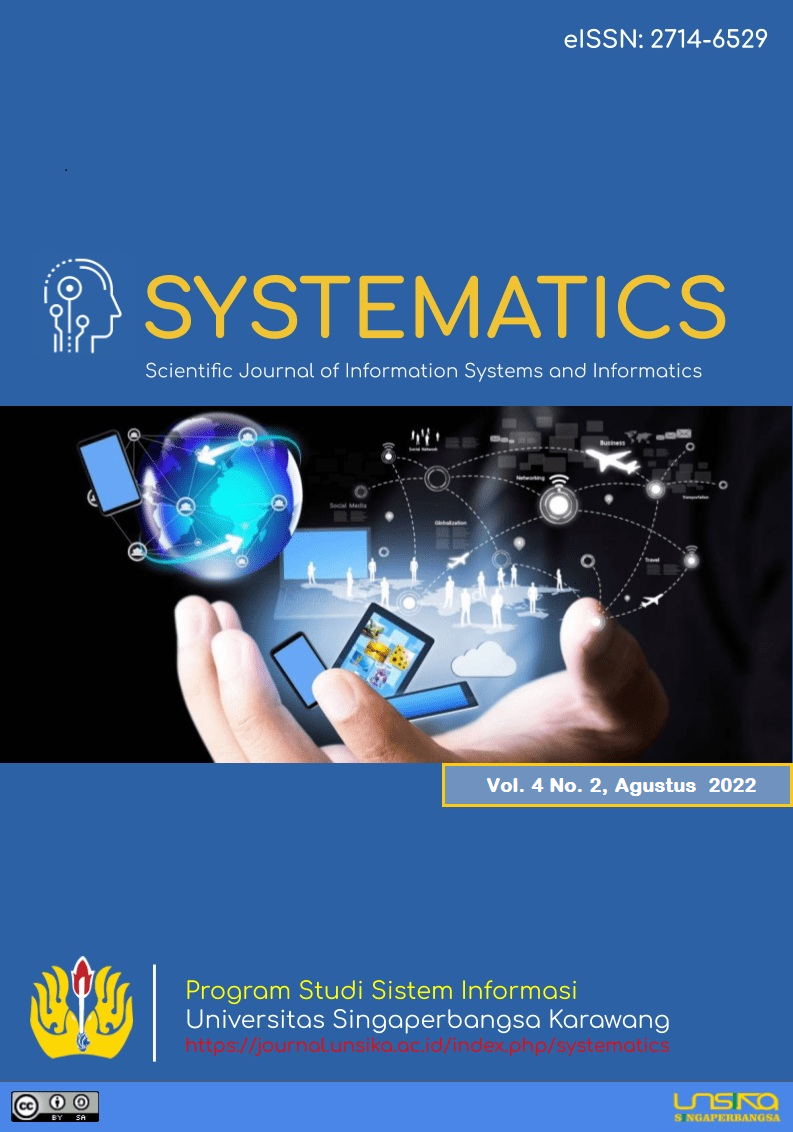Analysis of Public Sentiment of Covid-19 Dynamics on Social Media Using Support Vector Machine and Particle Swarm Optimization
Analisis Sentimen Publik Dinamika Covid-19 di Media Sosial Menggunakan Support Vector Machine dan Particle Swarm Optimization
DOI:
https://doi.org/10.35706/sys.v4i2.7006Abstract
Variants of covid in Indonesia continue to grow and make people required to stay at home and are not required to go out if they don't have important things, therefore many people who stay at home often play social media such as twitter, it is possible that many irresponsible people make opinions or hoaxes with a specific purpose to make tweets that are not in accordance with the facts, which are feared to make the public more panicked about the increase in this covid-19 variant. Therefore this study was conducted to classify tweets as positive, negative, and neutral. The methodology used is a text mining process with 4 modelings using Support Vector Machine and Particle Swarm Optimization. The results obtained from the 4th modeling produce an accuracy of 83% on the linear kernel. While the PSO modeling in scenario 4 with 90:10 data division resulted in the highest accuracy in linear and polynomial kernels of 86% and 87%, respectively. Other evaluation values also improved, such as precision to 90%, recall to 83%, and f1-score to 86%.
Downloads
References
F. Muhammad, N. M. Maghfur, and A. Voutama, “Sentiment Analysis Dataset on COVID-19 Variant News,” Systematics, vol. 4, no. 1, pp. 382–391, 2022.
N. Akbulaev, I. Mammadov, and V. Aliyev, Economic Impact of COVID-19. 2020.
G. Xu et al., “Since January 2020 Elsevier has created a COVID-19 resource centre with free information in English and Mandarin on the novel coronavirus COVID- 19 . The COVID-19 resource centre is hosted on Elsevier Connect , the company ’ s public news and information ,” no. January, 2020.
O. Dyer, “Covid-19: Indonesia becomes Asia’s new pandemic epicentre as delta variant spreads,” BMJ, vol. 374, no. July, p. n1815, 2021, doi: 10.1136/bmj.n1815.
A. Wong, S. Ho, O. Olusanya, M. V. Antonini, and D. Lyness, “The use of social media and online communications in times of pandemic COVID-19,” J. Intensive Care Soc., vol. 22, no. 3, pp. 255–260, 2021, doi: 10.1177/1751143720966280.
E. Novalia, J. Na’am, G. W. Nurcahyo, and A. Voutama, “Website Implementation with the Monte Carlo Method as a Media for Predicting Sales of Cashier Applications,” Systematics, vol. 2, no. 3, pp. 118–131, 2020.
H. Sahni and H. Sharma, “Role of social media during the COVID-19 pandemic: Beneficial, destructive, or reconstructive?,” Int. J. Acad. Med., vol. 6, no. 2, pp. 70–75, 2020, doi: 10.4103/IJAM.IJAM_50_20.
R. B. Koyel Chakraborty, Siddhartha Bhattacharyya, “A Survey of Sentiment Analysis from Social Media Data,” vol. 7, pp. 450–464, 2020, [Online]. Available: https://ieeexplore.ieee.org/stamp/stamp.jsp?tp=&arnumber=8951256&isnumber=9055454.
E. Miranda, M. Aryuni, R. Hariyanto, and E. S. Surya, “Sentiment Analysis using Sentiwordnet and Machine Learning Approach (Indonesia general election opinion from the twitter content),” Proc. 2019 Int. Conf. Inf. Manag. Technol. ICIMTech 2019, vol. 1, no. June, pp. 62–67, 2019, doi: 10.1109/ICIMTech.2019.8843734.
F. Sodik and I. Kharisudin, “Analisis Sentimen dengan SVM , NAIVE BAYES dan KNN untuk Studi Tanggapan Masyarakat Indonesia Terhadap Pandemi Covid-19 pada Media Sosial Twitter,” Prisma, vol. 4, pp. 628–634, 2021.
F. Z. Ahmad, M. Fauzi, S. Arifandy, M. R. Caesarardhi, and N. Aini, “Bagaimana Masyarakat Menyikapi Pembelajaran Tatap Muka : Analisis Komentar Masyarakat pada Media Sosial Youtube Menggunakan Algoritma Deep Learning Sekuensial dan LDA,” vol. 4, no. 2, pp. 40–46, 2021.
R. Arief and K. Imanuel, “Analisis Sentimen Topik Viral Desa Penari Pada Media Sosial Twitter Dengan Metode Lexicon Based,” J. Ilm. Matrik, vol. 21, no. 3, pp. 242–250, 2019, doi: 10.33557/jurnalmatrik.v21i3.727.
P. Arsi, R. Wahyudi, and R. Waluyo, “Optimasi SVM Berbasis PSO pada Analisis Sentimen Wacana Pindah Ibu Kota Indonesia,” J. RESTI (Rekayasa Sist. dan Teknol. Informasi), vol. 5, no. 2, pp. 231–237, 2021, doi: 10.29207/resti.v5i2.2698.
N. M. Maghfur, F. Muhammad, and A. Voutama, “Analysis of the Relationship between Public Sentiment on Social Media and Indonesian Covid-19 Dynamics,” vol. 3, no. 3, pp. 336–345, 2021.
A. Voutama and D. Wahyono, “Perancangan Sistem Informasi Transaksi Penjualan pada Toko Bata Kota Solok,” Systematics, vol. 2, no. 1, p. 39, 2020, doi: 10.35706/sys.v2i1.3637.
D. H. Wahid and A. SN, “Peringkasan Sentimen Esktraktif di Twitter Menggunakan Hybrid TF-IDF dan Cosine Similarity,” IJCCS (Indonesian J. Comput. Cybern. Syst., vol. 10, no. 2, p. 207, 2016, doi: 10.22146/ijccs.16625.
Z. Wu and D. C. Ong, “Context-Guided BERT for Targeted Aspect-Based Sentiment Analysis,” 2020, [Online]. Available: http://arxiv.org/abs/2010.07523.
Downloads
Published
How to Cite
Issue
Section
License
Copyright (c) 2022 SYSTEMATICS

This work is licensed under a Creative Commons Attribution-ShareAlike 4.0 International License.
Authors who publish with this journal agree to the following terms:
- Authors retain copyright and grant the journal right of first publication with the work simultaneously licensed under a Creative Commons Attribution-ShareAlike 4.0 International License. that allows others to share the work with an acknowledgement of the work's authorship and initial publication in this journal.
- Authors are able to enter into separate, additional contractual arrangements for the non-exclusive distribution of the journal's published version of the work (e.g., post it to an institutional repository or publish it in a book), with an acknowledgement of its initial publication in this journal.
- Authors are permitted and encouraged to post their work online (e.g., in institutional repositories or on their website) prior to and during the submission process, as it can lead to productive exchanges, as well as earlier and greater citation of published work (See The Effect of Open Access).







